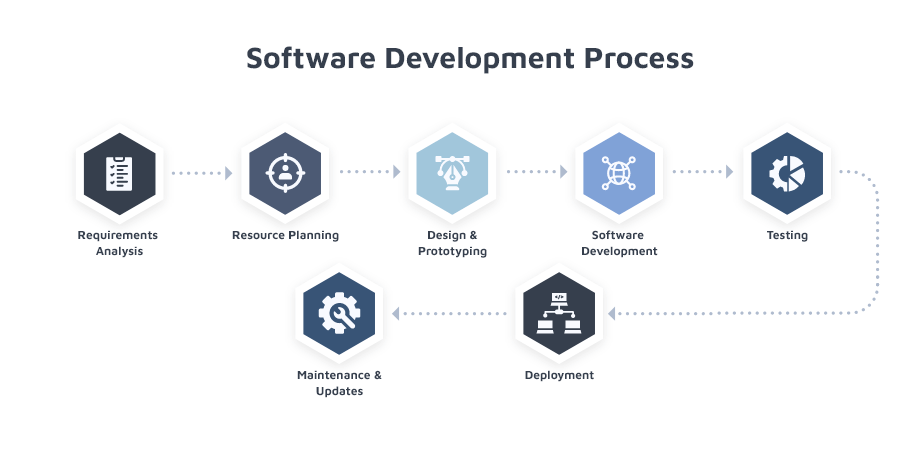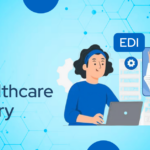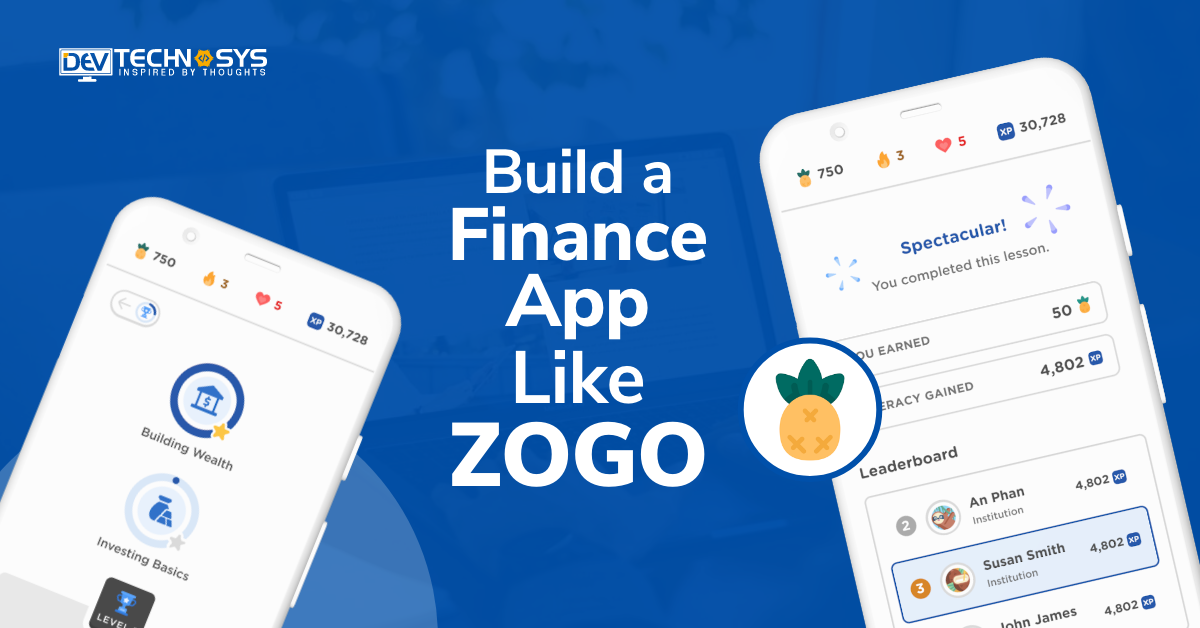In the fast-paced and ever-evolving world of software development, understanding the core activities of software development process is paramount to delivering successful, high-quality software solutions. These essential activities lay the foundation for building robust and reliable software applications that meet the demands of modern users.
In order to create an up to date software application software development companies first study and analyze the issues of the existing system, and then try to provide a solution for them.
They identify the loopholes in your system and the requirements that need to be fulfilled and then develop a customized product. They design software in such a way that the technical and the organizational components are integrated properly.
Any software product development process involves some basic core activities. Skilled professionals begin with system analysis, then system designing, followed by programming, testing, conversion, and then production and maintenance.

Software development services providers, while developing custom software, have to consider your organizational goals and processes. There are several other factors that need consideration like finance technical requirements, time constraints, et cetera.
Considering all of these factors, they will build any or all of the alternative systems like application software packages or, end-user development, et cetera.
Before finalizing a product custom software development company will follow the above-mentioned activities and undertake several stages of testing and recording.
These activities are not necessarily discreet and it is best to do them simultaneously in order to reduce the chances of errors in the final stages of development. In this blog, we will discuss the core activities of software development process, techniques and other aspects.
Table of Contents
Techniques Followed During Development Of Software Application
The core activities of a software development process are involved in software product development follow a basic model involving seven common steps which are followed by all the developers:
- Analyzing requirements
- A basic system design that is based on requirements
- Program designing
- Coding
- Testing and rerun in several steps
- Operation and maintenance
But this model is impossible to follow and the development process is, realistically speaking, more of an intricate web where each step needs to have a connection with the other activities.
For developing a perfect product, software development services providers will do repeated testing during the system designing phase, programming phase, the coding, and even during operations.
Testing has to be done repeatedly during the maintenance phase as well. Hence, to reduce the risk of errors, iteration is needed. After each activity, the chances of having errors increases, and tackling these risks during each process itself the best possible option.
Any Mobile and web development company prefers to handle the risk issue in a spiraling model. This involves analyzing the risk frequently during the development process.
Read More:- Ultimate Guide to Outsource Software Development in 2023
In the requirement analysis and planning process, constraints are identified and alternative solutions are derived after taking into account the budget that is involved in implementing these alternate strategies.
In the spiral model, risk evaluation and deriving alternative solutions are done several times during the various activities and several prototypes are finalized upon.
But now professionals who are hired for enterprise product development work in a hybrid model. Here they first develop a prototype based on the basic requirements, run it for a short time period, find the loopholes, and then develop a second prototype that contains all the rectifications for the shortcomings of the previous version. This is done several times till a final satisfactory product is developed and then load testing is done.
The first activity in software development is the analysis part. In the OOA model, (Object-Oriented Analysis), the requirements are oriented around objects integrating both processes and data.
OOA investigates the problem and analyses what the system has to do. It helps to analyze the problem domain. In design activities, the OOD (Object-Oriented Design) model is followed where implementation constraints are added to the concepts that are developed by OOA.
OOD helps to find solutions to the existing problems and how the system will fulfill the needs. It provides the logical software to solve the problems that arise during test runs.
Detailed Study Of Software Development Models
Several standard models for SDLC (Software Development Life Cycle) that are followed by every software development company are as follows-
The Waterfall Model –
It is a very straightforward, step-by-step model where each step has its own sub-plan and completion of one step leads to the next step. In this model, the core activities of software development process and small details are often neglected and the entire process becomes erroneous.
Agile Model-
The whole process is segregated into smaller cycles to create a working prototype very quickly. The outcomes of the different cycles are simultaneously tested and incorporated into the next version.
The Iterative Model –
A prototype is created very quickly with a very small budget. Then repeat testing is done and rapid and successive versions are developed erasing the flaws of the previous version, but this method needs a lot of resources.
The Spiral Model –
It is a very flexible model that also emphasizes repetitions. Each of the activities like planning and designing is done over and over again while analyzing the constraints and making adjustments in each process and at each pass.
The V-Shaped Model –
The verification and validation model has a step-by-step approach like the Waterfall model. But each of the development stages has a corresponding testing phase. This model is helpful when no sudden and unknown requirements arise. It is very difficult to move a step backward and make adjustments in this model.
The Big Bang Model –
It is used when the project is very small and no proper planning is done. It does not follow a specific step-by-step process, all the resources are utilized in the development phase while planning, and analyzing is not given due importance. Since the requirements are not very clear it becomes a risk to apply this model for large and complex projects.
Why The SDLC (Software Development Life Cycle) Is Followed
Some of the reasons why all software development companies opt for SDLC are as follows:
- It is an option for proper planning scheduling, resourcing, and estimating which are the basic requirements for developing a quality product.
- It offers a framework for a set of activities and deliverables
- It makes the planning process more transparent and visible to clients. This reduces the number of adjustments required in the final stages.
- It helps to track the core activities of software development process and control it.
- Avoiding time-delay in the various activity phases does control the expenses.
- Client involvement is increased which makes communication more regular, easier, and fruitful.
- It reduces the risks involved in the final run of the project so that you do not have to restart from the planning process.
- It also reduces Overhead expenses and other hidden costs which makes the total estimation spiral up.
- Promotes teamwork which directly increases the productivity of human resources.
Essential Steps Involved In Software Development Process
Almost all software development companies follow a series of steps while developing custom software. The main steps that are involved in SLCD (Software Life Cycle Development) are:
- Planning
- Analysis Of Requirements
- Software Design And Prototype
- Testing
- Deployment
- Maintenance
1. Planning
This step involves brainstorming and discussions on the various factors that will influence the development process. The designing and developing team along with the project head and the stakeholders reach an agreement on factors like:
- Allocation of human and material resources
- Project scheduling
- Cost estimation
- Provisioning the resources.
After an agreement on the project planning, procurement of resources, cost, and schedule of the project are done a rough draft of the project for the team to follow is made.
2. Analysis Of Requirements
Identification of the requirements of the client is first done so that very few adjustments are required in the final stages. Customer software development companies and the stakeholders go for several rounds of detailed communication about the requirements of the business.
Designers and the project manager then work upon these customer-specific requirements to make a rough sketch of the software model.Then they identify the important core activities of software development process that need to be automated and optimized beforehand with software for proper integration with the software product.
Read More:- What Are The Most Important Tips While Developing Custom Software?
3. Software Design And Prototype
After proper requirement analysis is done a rough architecture of the software application is built. Chances are that some possible flaws can be detected at this stage and relevant precautions are taken.
The software designers follow some standard patterns for developing both the architecture and the software. The mobile app development company develops several prototypes to compare the various solutions and identify the best option that meets the business requirements. This rapid prototyping process identifies the risks involved and eliminates the chances of errors.
4. Software Development And Programming
Next, the team starts coding the software. Continuous communication with the business organization is needed throughout the process so that the process develops further in the right direction.
Expert professionals create the components and functions required for the software in this step. The resulting application is now to be tested.
5. Testing
The most important step during the software development process is the testing phase. Developers conduct repeated tests of the various functions.
The code quality is tested then each unit performance is tested one by one. Step-by-step integration is also tested and then product performance is tested.
Finally, the security of the application is also checked. Several other tests like load capacity also undergo the iteration process. Flaws in the coding or software errors and hardware malfunction are assessed and changes are made to erase these flaws. Bug fixing is also done.
6. Deployment
The developed software is allowed a pilot run so that all the stakeholders can assess it. This helps to create complete customer satisfaction. This is done in an automated mode with a continuous integration system to make the whole process faster.
7. Maintenance
The working model is then produced. It is frequently updated and maintained and any new changes are incorporated regularly. Any bugs and defects, if identified, are taken care of immediately. Bug fixing sometimes can also lead to other processes malfunctioning, such regressions are also quickly dealt with.
Risks Involved In Software Development Process
- The skill and the experience of the professionals who are involved, the productivity of the team, and even holidays, late arrivals, or availed leaves affect the development process significantly.
- Sudden customer requirements for additional features will lead to the redevelopment of the present prototype and incorporation of changes. This will cause significant delays and wastage of existing resources.
- Existing software may not run smoothly due to technical issues and system failures. This causes unexpected delays and extra expenditure.
- Inadequate research work will not be able to produce a quality application that can give 100% customer satisfaction.
- Underestimation of the development costs, bad budgeting, and deployment of funds win hamper resource allocation. This will result in poor performance and products that lack quality and durability.
- Unpredictable flaws and imperfections in the design or program coding can occur during the test runs. This might require entire codes to be rewritten. This involves a delay in final production as preliminary steps will have to be repeated.
- Delay in time to prepare prototypes will directly delay the final product.
- Non-compatible hardware will not be able to integrate with the development software so an immediate up-gradation of the hardware will be needed.
- A gap in communication among developers and stakeholders can lead to misinformation and wrong analysis of requirements. This will lead to more errors and more adjustments in the final stages.
- Administrative problems may lead to improper collaboration between the task force and the management, which will hamper the quality of the product and cause unnecessary delays.
- Unexpected problems with maintenance, scalability, or performance
Conclusion
Software development needs precise steps and procedures that are termed as Software Development Life Cycle. The quality of the software product on the processes followed by software development companies.
The SDLC can be adjusted to meet the needs of particular projects. It also identifies the precise actions that are needed to be taken to achieve the purpose of the software application.
The product that is developed will only be successful if it fulfills all the clients’ requirements and achieves customer satisfaction. The cost of software development varies a lot depending on several factors.
But in India, it is comparatively low so many international companies are looking to India for their enterprise product development. SDLC allows maximum automation, documentation, and management control of an enterprise so it is rigorously followed by all developers.

























